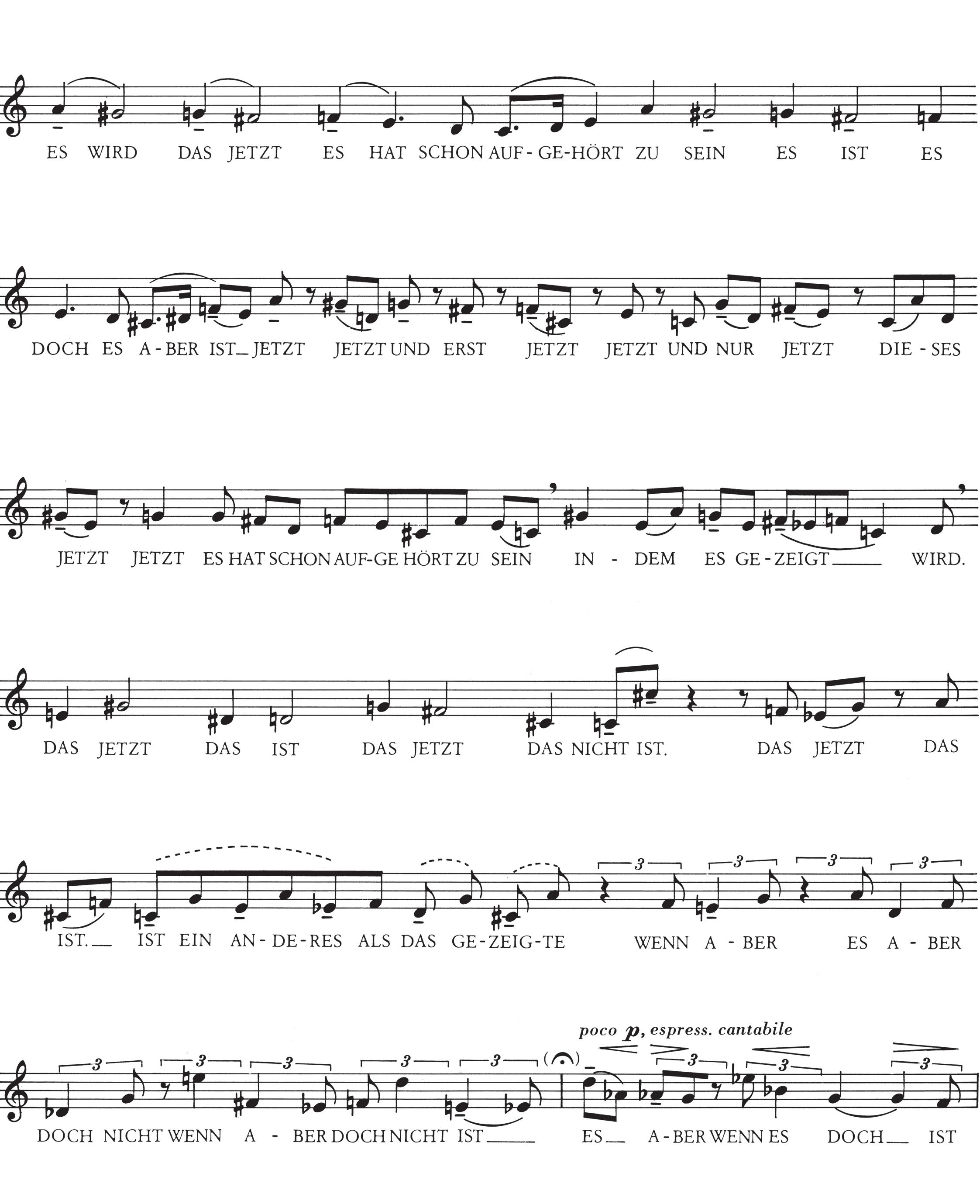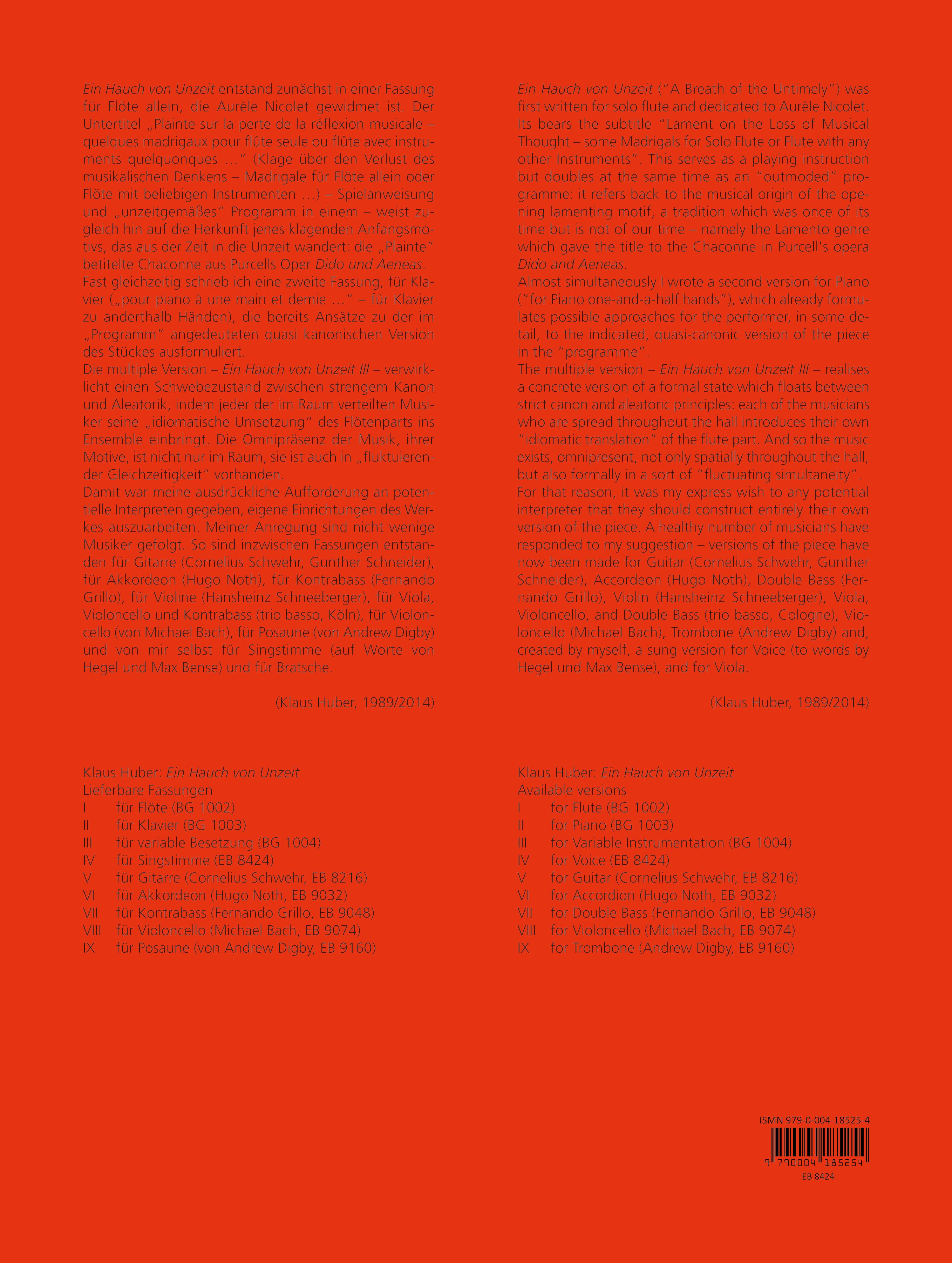




(Plainte sur la perte de la réflexion musicale)

Fassung für Singstimme vom Komponisten EB
Es wird das Jetzt gezeigt, dieses Jetzt. Jetzt, es hat schon aufgehört zu sein, indem es gezeigt wird, das Jetzt, das ist, ist ein anderes als das gezeigte, und wir sehen, dass das Jetzt eben dieses Jetzt ist: indem es ist, schon nicht mehr zu sein.
Das Jetzt, wie es uns gezeigt wird, ist ein gewesenes, und dies ist seine Wahrheit, es hat nicht die Wahrheit des Seins. Es ist also doch dies wahr, dass es ein gewesenes ist.
(Max Bense – unter Verwendung eines Textes von Georg Wilhelm Friedrich Hegel –, aus: Einführung in die informationstheoretische Ästhetik. Grundlegung und Anwendung in der Texttheorie, Reinbek: Rowohlt 1969)
© Erbengemeinschaft Max Bense
Anmerkungen
Der Text ist die phonetische Schreibweise des Wortes „Jetzt“, das heißt also erst J-ə und zwar möglichst ohne Vibrato den Vokal verändern, dann poco cresc. und (evtl. mit Vibrato) in den Sprechgesang („J etzt eben“) übergehen.

= möglichst schnell, die Tonhöhen sind relativ, also nicht genau einzuhalten.
Dann jeweils das J auf dem Ton f² ohne Vibrato singen und anschließend auf ə den angegebenen Triller, sofort schnell (nicht anlaufen lassen); bei J wieder ohne Vibrato usw.
m - ə kommt von dem Wort „mehr“. Es wird gesummt und zwar mit den angegebenen Nebennoten (vom Ton g ausgehend) improvisieren = frei abwechseln.
Die Wellenlinie bedeutet: immer in Bewegung sein, nie auf einer Tonhöhe verweilen. Das Ganze ist wie ein unregelmäßiger großer Triller über verschiedene Tonhöhen und klingt wie ein Gewimmer, das sich langsam zum Vokal ə öffnet und, je nach Notation, sich auch wieder zum m (Summen) schließt.
Bei der Urfassung von Ein Hauch von Unzeit (für Flöte) sind diese Stellen Flageolette. Die Stimme soll versuchen, einen schwebenden Flageolett-Klang zu imitieren (ppp possibile). Vokale unmerklich ineinander übergehen lassen –möglichst gerade schwebende Töne.

= frei, d. h. auf keinen Fall alle Tonhöhen gleich lang singen, sondern organisch fließend. Den letzten Ton länger als alle anderen halten. (Die verschiedenen Vokale haben verschiedene Obertöne, die mitschwingen.)
„smorzando!“ = gedämpft (wie ein Saiteninstrument mit Dämpfer): o auf dem Ton c¹, m auf dem Ton des¹. Das oist jeweils lang, das m nur kurz dazwischen (wie ein Seufzer). Auch hier nicht stur regelmäßig wechseln, sondern organisch (evtl. etwas rallentando – aber nicht viel).
Für das ganze Stück ist das Wichtigste die absolute Ruhe, die möglichst auch beim Ausführenden entstehen sollte. Die Fermaten sind mitunter das Wichtigste. Sie können, wenn man die Ruhe findet, sehr lang werden. Ein Hauch von Unzeit – die Zeit löst sich quasi auf!
The Now is shown, this Now. Now it has already ceased to be, in that it was shown, that Now, which is, is other than the Now which was shown, and we see, that the Now is precisely this Now: in that it is, it is no more.
The Now as shown to us, is a thing which has been, and this is its truth, it does not possess the Truth of Being. So this much, then, is true: it is a thing which has been.
The text consists of the phonetic spelling of the word ”Jetzt“ (”Now”) i.e. first J-ə , changing the vowel without vibrato if at all possible, then poco cresc. (with vibrato ad lib.) making a transition to Sprechgesang („J etzt eben“).

= as fast as possible; the pitches are relative, so no need to keep to them exactly.
Then sing the J each time on the f² pitch without vibrato and then sing the indicated trill straightaway on ə . The trill must be fast immediately, without a ”run-up”. Then on the J once more without vibrato, and so on.
m - ə comes from the word ”mehr” (“more“). Hum this sequence and then improvise (= alternate freely) on the indicated neighbouring pitches (starting on g). The wavy line means always keep moving–never rest on one pitch. The whole gesture should sound like an irregular, wide trill moving across different pitches. The effect should sound like whimpering, which slowly opens out to the vowel sound ə , and then, according to the notation, closes to an m (i.e. humming).
In the original version of Ein Hauch von Unzeit (for Flute) these passages are harmonics. The singer must attempt to imitate a floating harmonic sound (ppp possibile). The vowels should shift imperceptibly from one into another–if possible without disturbing the steadily floating harmonic pitches.

= freely, i.e. on no account sing two pitches for the same duration: let them flow organically. Sing the last note longer than the others. (The different vowels have different overtones, which vibrate sympathetically.)
”smorzando!” = damped or muted (like a string instrument with a mute): o on the pitch C¹, m on the pitch Db¹ Each of the o sounds is long; the m sounds between them are short (like a sigh). Here again the notes should not alternate with stubborn regularity, but instead organically (perhaps a little rallentando – but not too much).
The most important requirement for the whole piece is absolute stillness, which should as far as possible emanate from the performer. The pauses are occasionally in this respect the most important element. These may, if one can find the necessary stillness, become very long.
Ein Hauch von Unzeit (A Breath of the Untimely) – time almost dissolves!
Aufführungsdauer: 20 Minuten
Performing Time: 20 minutes (Translation: David Alberman)
(Plainte sur la perte de la réflexion musicale)
Klaus Huber, 1972 Fassung für Singstimme vom Komponisten (1976)


Dies ist eine Leseprobe.
Nicht alle Seiten werden angezeigt.
Haben wir Ihr Interesse geweckt?
Bestellungen nehmen wir gern über den Musikalienund Buchhandel oder unseren Webshop entgegen.
This is an excerpt.
Not all pages are displayed.
Have we sparked your interest?
We gladly accept orders via music and book stores or through our webshop.
